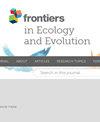Declines in Common and Migratory Breeding Landbird Species in South Korea Over the Past Two Decades
IF 2.4
3区 环境科学与生态学
Q2 ECOLOGY
引用次数: 10
Abstract
Population declines in terrestrial bird species have been reported across temperate regions in the world and are attributed to habitat loss, climate change, or other direct mortality sources. North American and European studies indicate that long-distance migrants, common species, and species associated with grasslands and agricultural lands are declining at the greatest rates. However, data from East Asia on avian population trends and associated drivers are extremely sparse. We modeled changes in occupancy of 52 common breeding landbird species in South Korea between 1997–2005 and 2013–2019. Thirty-eight percent of the species showed evidence of declines, and seven of these were declining severely (46–95%). Occupancy of Black-capped Kingfisher (Halcyon pileata) populations have dropped the most precipitously over the study period. Among declining species, long-distance migrants (9/20) and common species (14/20) showed more rapid declines than other groups. Declines of five species were associated with climate change, and two species appeared to be affected by land-cover change. However, causes of change in occupancy of other species (46/52) remains cryptic. Based on our results, we suggest an immediate re-evaluation of species’ conservation status and legal protection levels for seven severely declining species in South Korea, and a dedicated survey design and analysis effort for the continued monitoring landbird populations. Because many species exhibiting declines migrate from beyond national boundaries, international collaborations will be required to better quantify population trends across the full annual cycle, and to understand mechanisms for these declines.在过去的二十年里,韩国常见和候鸟物种的减少
据报道,世界温带地区的陆生鸟类种群数量下降,其原因是栖息地丧失、气候变化或其他直接死亡来源。北美和欧洲的研究表明,长途迁徙物种、普通物种以及与草原和农业用地有关的物种正在以最快的速度减少。然而,来自东亚的关于鸟类种群趋势和相关驱动因素的数据极其稀少。我们模拟了1997-2005年和2013-2019年韩国52种常见繁殖陆鸟的占用变化。38%的物种有下降的迹象,其中7个物种严重下降(46% - 95%)。在研究期间,黑冠翠鸟(Halcyon pileata)种群的占用率急剧下降。在下降的物种中,长途候鸟(9/20)和普通物种(14/20)的下降速度比其他类群更快。5个物种的减少与气候变化有关,2个物种似乎受到土地覆盖变化的影响。然而,其他物种占有变化的原因(46/52)仍然不清楚。在此基础上,我们建议立即对韩国7种严重下降的陆鸟物种的保护状况和法律保护水平进行重新评估,并为继续监测陆鸟种群进行专门的调查设计和分析。由于许多物种从国界之外迁移而来,因此需要国际合作来更好地量化整个年周期的种群趋势,并了解这些下降的机制。
本文章由计算机程序翻译,如有差异,请以英文原文为准。
求助全文
约1分钟内获得全文
求助全文
来源期刊

Frontiers in Ecology and Evolution
Environmental Science-Ecology
CiteScore
4.00
自引率
6.70%
发文量
1143
审稿时长
12 weeks
期刊介绍:
Frontiers in Ecology and Evolution publishes rigorously peer-reviewed research across fundamental and applied sciences, to provide ecological and evolutionary insights into our natural and anthropogenic world, and how it should best be managed. Field Chief Editor Mark A. Elgar at the University of Melbourne is supported by an outstanding Editorial Board of international researchers. This multidisciplinary open-access journal is at the forefront of disseminating and communicating scientific knowledge and impactful discoveries to researchers, academics and the public worldwide.
Eminent biologist and theist Theodosius Dobzhansky’s astute observation that “Nothing in biology makes sense except in the light of evolution” has arguably even broader relevance now than when it was first penned in The American Biology Teacher in 1973. One could similarly argue that not much in evolution makes sense without recourse to ecological concepts: understanding diversity — from microbial adaptations to species assemblages — requires insights from both ecological and evolutionary disciplines. Nowadays, technological developments from other fields allow us to address unprecedented ecological and evolutionary questions of astonishing detail, impressive breadth and compelling inference.
The specialty sections of Frontiers in Ecology and Evolution will publish, under a single platform, contemporary, rigorous research, reviews, opinions, and commentaries that cover the spectrum of ecological and evolutionary inquiry, both fundamental and applied. Articles are peer-reviewed according to the Frontiers review guidelines, which evaluate manuscripts on objective editorial criteria. Through this unique, Frontiers platform for open-access publishing and research networking, Frontiers in Ecology and Evolution aims to provide colleagues and the broader community with ecological and evolutionary insights into our natural and anthropogenic world, and how it might best be managed.
 求助内容:
求助内容: 应助结果提醒方式:
应助结果提醒方式:


